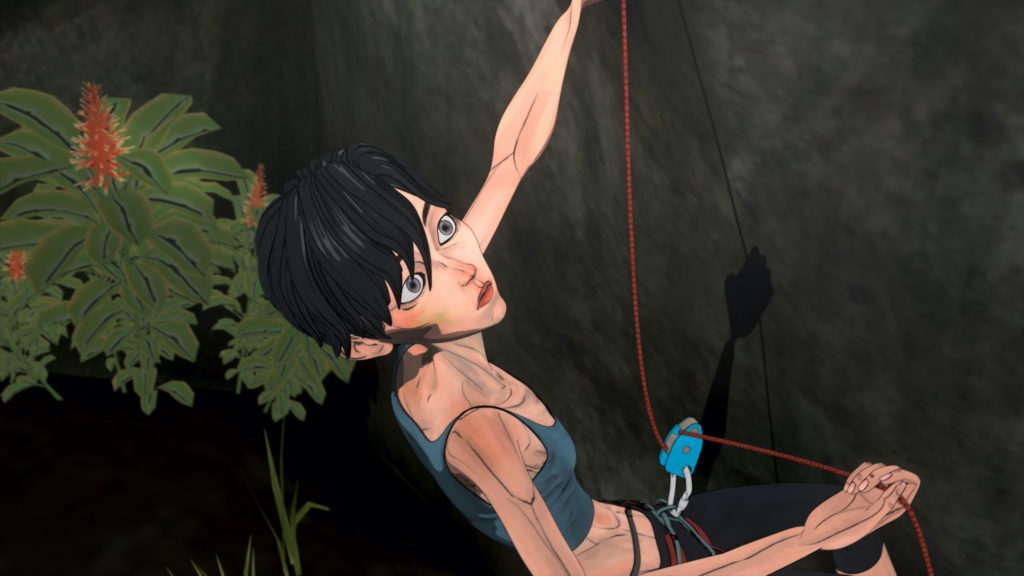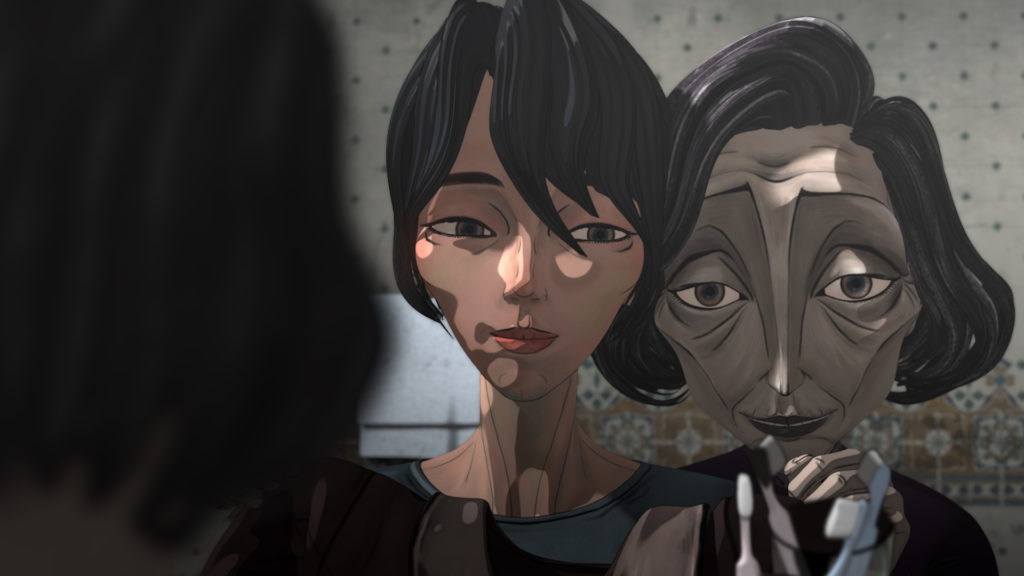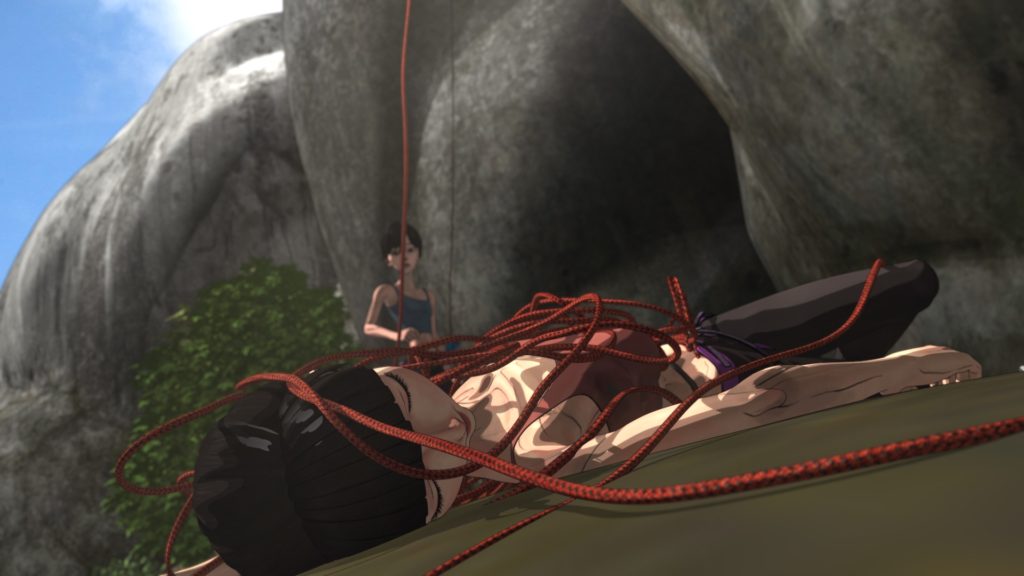Climbing
November 15, 2021 · 0 comments
By Andrew Osmond.

Fans of Perfect Blue are recommended to catch a new animated psycho-drama feature, Climbing, that is screening on 18th November as part of the London Korean Film Festival. Like Perfect Blue, Climbing is about a young woman for whom reality starts to skew. Se-hyeon is a dedicated sports climber, intent on glory… but then she starts to receive messages from another version of herself, pregnant and in a wheelchair. Is Se-hyeon cracking up? Or is reality?
Climbing is perhaps the first animated feature to be centred around pregnancy, and not in a saccharine way. The director, Kim Hye-Mi, is candid about the film being inspired by her own experience of pregnancy. Thanks to the London Korean Film Festival, I was able to interview her about her work.
Can you say a little about how the film was made – in particular, how long it took to animate, how many people worked on it, and what software was the most useful to you on the film?
I received funding from the Korean Academy of Film Arts Feature Film Programme, and began work on Climbing in 2017. The pre-production stage (script, design, and storyboard) took one year. From 2018, the main production stage (3D modelling, mapping source design, animation, rendering, etc) took two years and five months. The post-production took four to five months, bringing the total production time to three and a half years. Less than thirty members of staff created the animation using MAYA 3D animation software.
The film contains some very visceral, violent images of ending a pregnancy. You have talked about how the film was influenced by your own feelings when you were pregnant. Were these violent images based on things that you visualised at the time?

I was never able to get used to the fact that I was pregnant. Reality began to feel kind of unreal. In my dreams, I kept appearing as me, but before I was pregnant. And then sometimes I dreamt that I’d drunk alcohol, realised when it was too late, and woke up in shock. I often experienced the dreamlike feeling of the ‘me’ of reality mixing with the ‘me’ of the past. I think this definitely had a big effect on the atmosphere of the film.
And I think this was the inspiration for the story, where the main characters of the climber and mother exist in parallel universes, with pregnancy a medium influencing them. Because I focused on the fear and insecurity that comes with pregnancy, I chose images that would bring out those emotions. Rather than universal positive images of pregnancy, I pursued those that were exaggerated and intense.
The film has been described in some places as a horror film. Are you happy with that description, or do you think it is a misunderstanding of the film?
Though there are many films dealing with the positive aspects of pregnancy, I felt that films of the opposite type were rare. Even more unusual are ones that focus on the internal rather than external changes that come with pregnancy. Of course, it could be that these films exist, but I’m just not aware of them.
So, I wanted to reveal the entirety of the dark inner world that women experience during pregnancy. I aimed to create a three-dimensional expression of its various aspects using the mystery horror genre. I think it’s a process similar to how it is only by delving into darkness that you come to realise the existence of light—something taken for granted—in a new way.
I appreciated the fact that the characters did not look like people in a Disney animation, nor like people in a Japanese animation. The character design for the film is very distinctive; it feels “real” and far from the stereotypes of how characters in animation, especially women, look. Can you talk about the graphic style of the character designs, and why you decided on this style for the film?
I chose a lean and muscular body type distinctive to professional climbers, and used a somewhat distorted, unrealistic form for the characters to suit the content of the film.

For characters with proportioned bodies, if the animation is unnatural, this further exaggerates the awkwardness. And if the characters are similar to those from existing 3D animations (Pixar, Disney, etc), we immediately associate them with high quality. And so, for my film, I hoped to create an animation style unique to Climbing. I felt that differentiating my characters from those of pre-existing animations would further emphasise Climbing’s unique character.
Given the budget limits of an independent feature-length animation, I had to do my best to make realistic judgement calls wherever I could.
When you were making the film, did you come to think of the “climber” Se-hyeon and the “pregnant” Se-hyeon as being two different characters? Or did you always think of them as being the same person?
I think they are the same person, but they make different choices depending on the position they are in. They are both ‘me’, but if it’s something I haven’t experienced, I won’t be able to understand my own self.
My impression was that the two versions of Se-hyeon looked different. Obviously, that was partly because they wore different kinds of clothes, but were they also designed differently in the animation?
The hair length and the shape of the pregnant stomach were designed differently. Aside from that, everything was the same. Maybe the reason they appeared different was that their desires were different?
The climbing scenes give a very vivid sense of what the experience is like, how much physical effort it involves. Do you have your own experience of climbing, or did you talk with sports climbers?
I had a group lesson with the other members of staff. I’m not very strong, so climbing is difficult for me. I visited the climbing locations a number of times, and searched out lots of videos to see how the professionals moved.
Your film’s ambiguous handling of reality sometimes reminded me of the work of David Lynch or Satoshi Kon. Were you thinking of either director, or did you have any other artists in mind?
I was inspired a lot by Darren Aronofsky’s Black Swan and Jennifer Kent’s The Babadook. And I of course love Satoshi Kon’s Perfect Blue.
(Minor spoiler) I thought the last moments of the film were designed so that different audience members, and perhaps different women, could have very different feelings about the end, and have a lively argument after the film. In your experience, have viewers of the film understood the ending in different ways?
Audiences have taken the end of the film in different ways, and there were some who had the same thoughts as me. What’s clear is that both the foetus and the mother are trying their very best to be born anew. Nothing is a given.
Climbing is screened on Thursday 18th November at 9 p.m. at the Genesis Cinema near Stepney Green station.
Leave a Reply